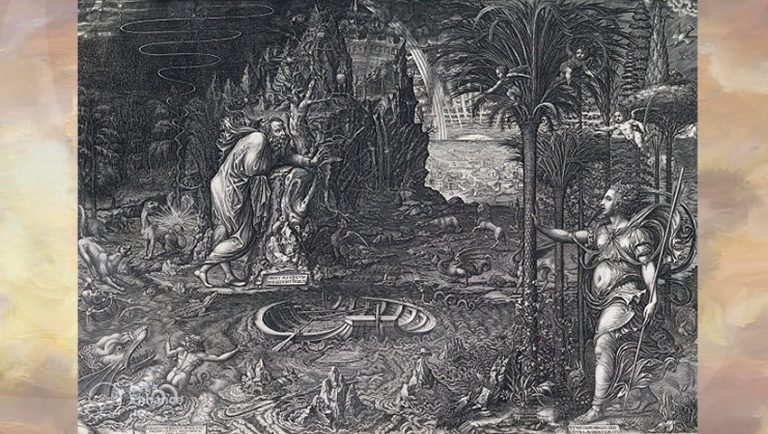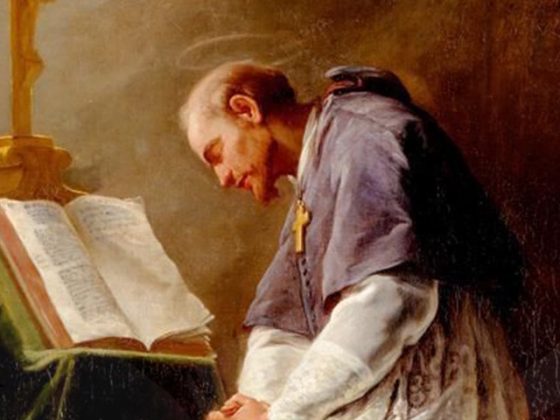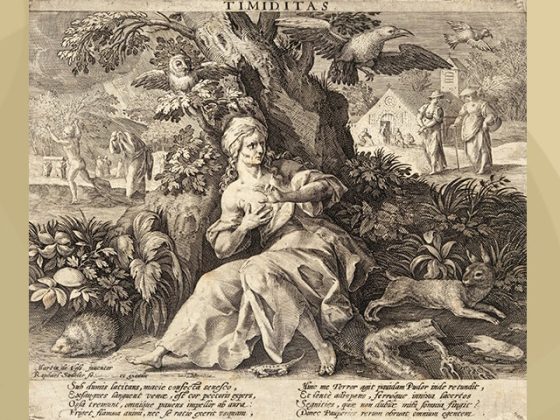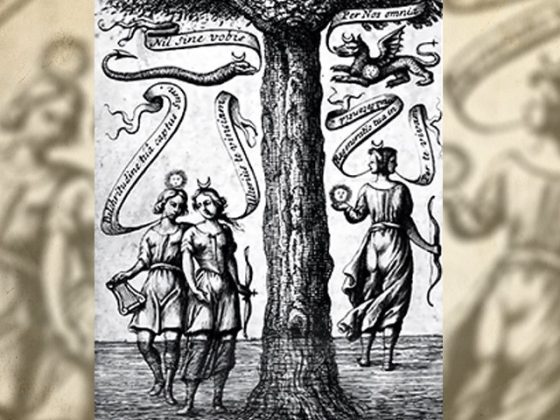Very endearing readers:
I am pleased to send you this new engraving which, according to scholars, is one of the most enigmatic engravings that have been made for centuries.
The author entitled this work…:
…ALLEGORY OF LIFE
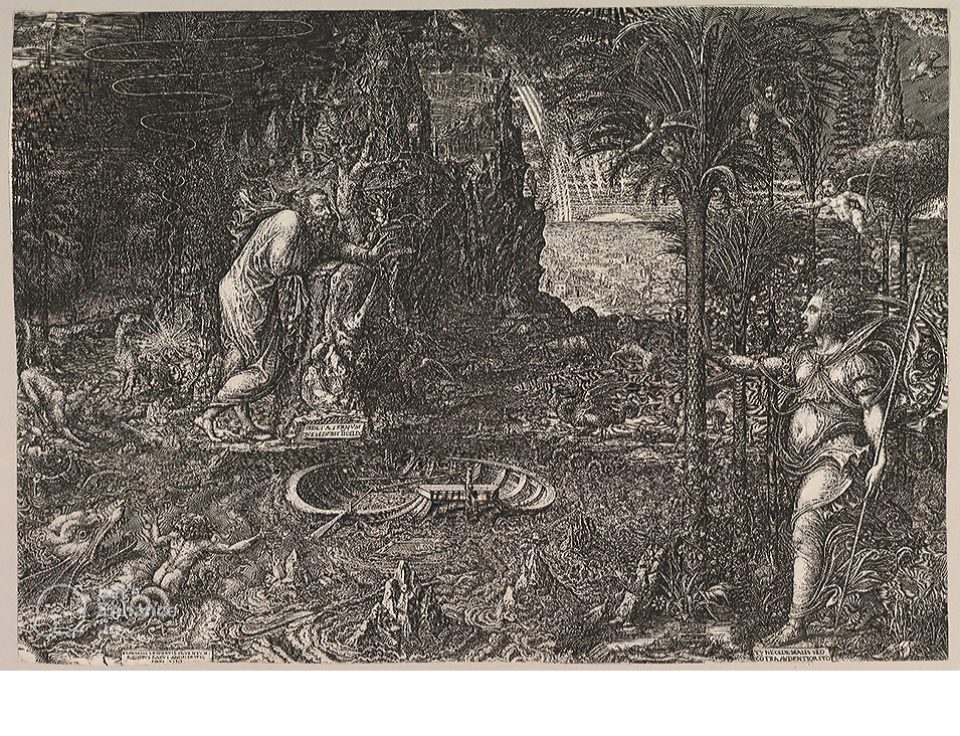
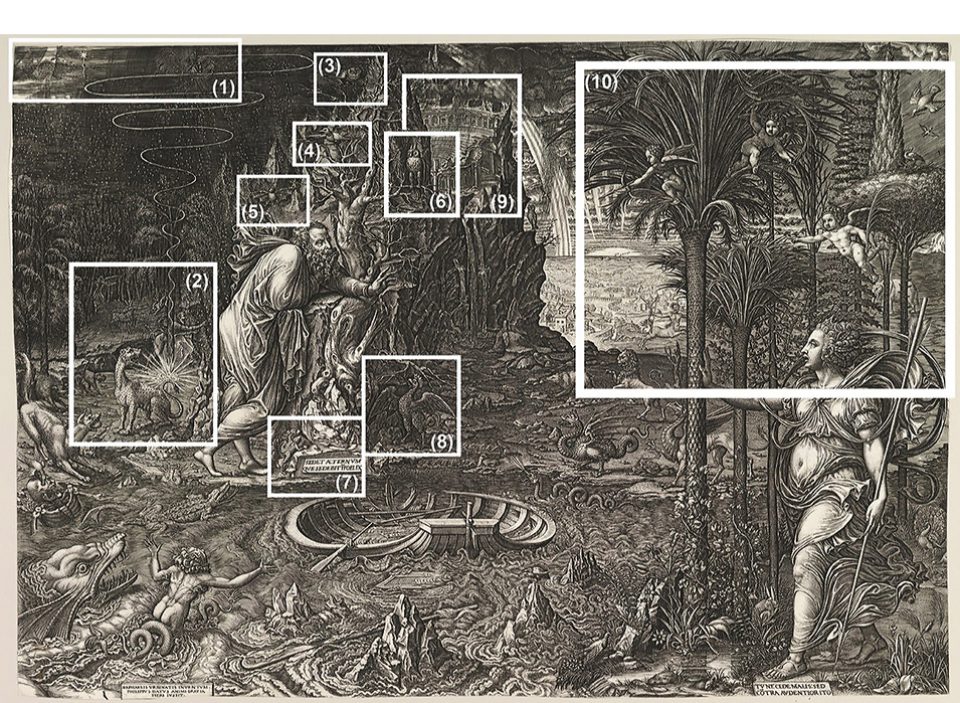
It is attributed to Giorgio Ghisi, who would have drawn it in 1561. It is his most famous print. Some have called this engraving The Dream of Raphael.
“This is one of the most impressive and mysterious Italian engravings. No one has yet been able to fully explain its symbolism, but it seems clear that it represents the perilous journey across the sea in a boat full of holes, with rocks and wild beasts lurking before the sage –on the left– in his search for Truth.
The two verses at his feet are taken from Virgil's Aeneid, Book VI, verses 617 and 95.
The greatest paradox presented by the printing is found in the Latin text at the bottom left: RAPHAELIS VRBINATIS INVENTVM. PHILIPPVS DATVS ANIMI GRATIA FIERI IVSSIT, ‘The Invention of Raphael of Urbino. Filippo Dati ordered that it be done in gratitude.' In the 16th century this would have been understood to mean that Raphael designed –”invented”– the composition, which would then have been engraved by Ghisi, an engraver from Mantua who used to work according to the designs of others. But, as commentators have long recognized, the composition could not have been designed by Raphael, who died in 1520. The style of the engraving is much later, and the only link with Raphael is in the position of the man, which derives from one of the philosophers of The School of Athens.
It is not entirely clear why Ghisi should have put an inscription on his drawing that he must have known was misleading, not to say false. Was it to deceive collectors or is there a more esoteric or private joke behind it by Dati, the man who commissioned it? Answering this question is complicated by the fact that no one has yet managed to discover who Dati was.”
Another description of the engraving comments:
“A boat was wrecked in a turbulent and rocky river, in the foreground. On the left, a bearded man, leaning on the trunk of a dead tree, with a bat, two owls and a crow above him. Under the tree a rock and a plaque with an inscription from Virgil's Aeneid, book VI, verse 617: SEDET AETERNVM QVI SEDEBIT IFOELIX, ‘He is sitting, nevermore to rise.' The message refers to Theseus, who was trapped in Hades because of his lustful transgressions —the verse says, “Some roll huge boulders up; some hang on wheels, lashed to the whirling spokes; in his sad seat
Theseus is sitting, nevermore to rise;…” ─. His boat is not in a condition to cross the river Styx. The man is surrounded by monstrous creatures that look at him venomously. His only hope seems to come from the goddess-like woman, appearing on the right with a long spear and under her foot there is a plaque with the message: TV NE CEDE MALIS: SED CONTRA AVDENTIOR ITO, ‘Do not give in to evil, but face it with more boldness.' Another translation given to the text is: ‘Do not give up in the face of adversity, but face it with more boldness.'“
The meaning of the woman who appears in the engraving to rescue the philosopher could be the divine Minerva ─Isis, Stella Maris, the Divine Mother─.
On the plaque seen in the center of the ship is written: GIORGIVS GHISI MAT. F 1.5.6.1., which must be the signature of the author and the date.
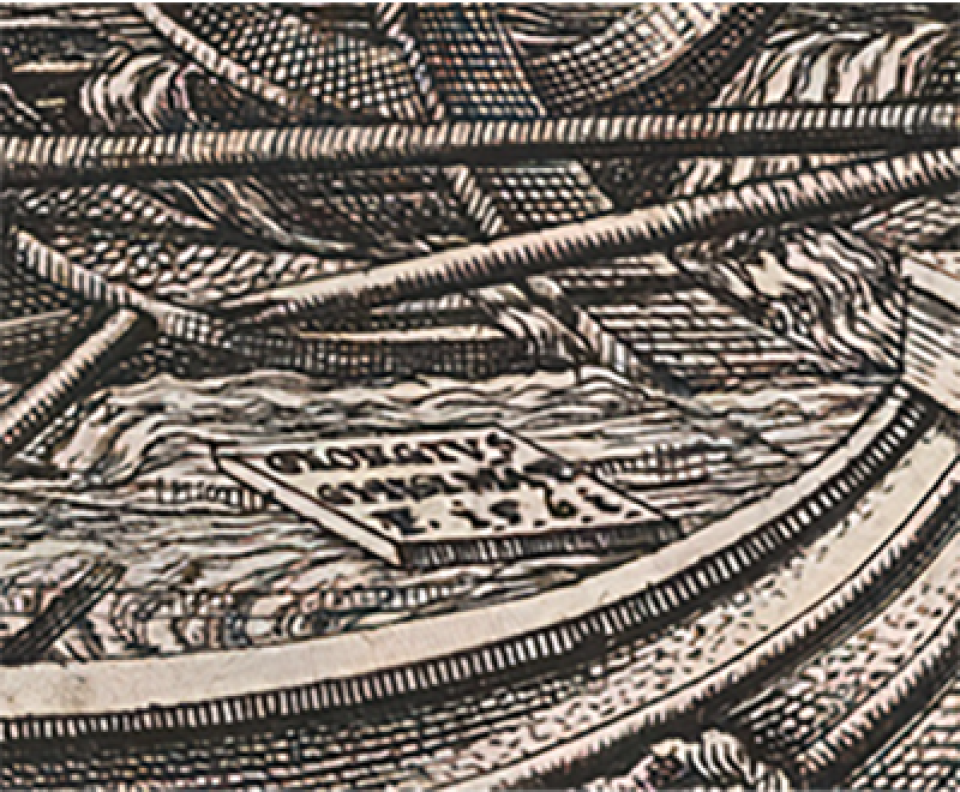
In the upper left part of the drawing there are some intriguing symbols, a serpentine thread of light that ends at the top, where three faces can barely be distinguished, three human forms ─see detail 1─ representative of the power of God, which come to allegorize the three breaths of the Eternal, the three divine breaths: holy affirming, holy denying and holy conciliating. Such divine forces have for millions of years been observing the unfoldment of the human races, their destiny according to the choice that these races make for the purpose of the existence that has been given to them.

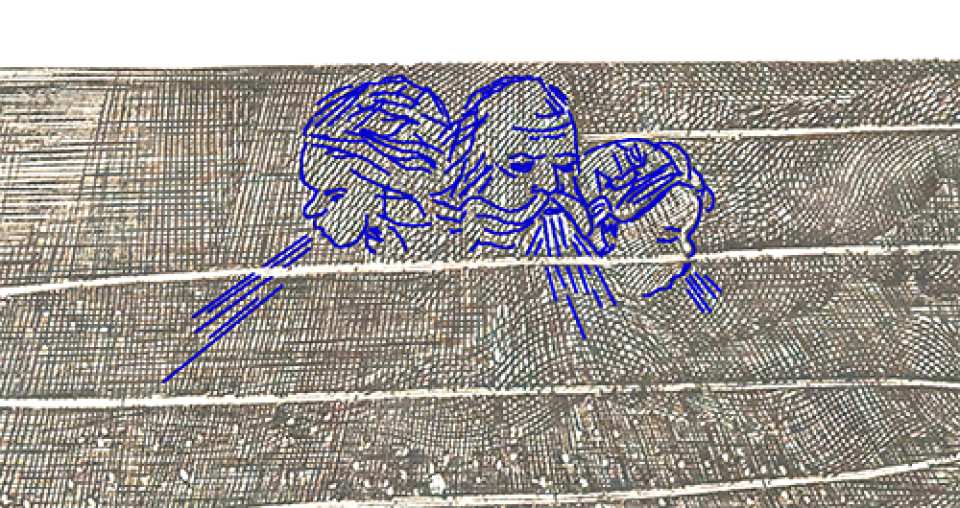
To continue in the study of this cryptic engraving we will say that, certainly, what we see above all is the contrast between two worlds or two realities, the one that points us to a paradisiacal area and the other that shows us a real chaos.
In the chaotic area we first find an old man ─a devotee of the Secret Path─ leaning on a dry tree, a symbol of sexual decadence, as transmutatory art so well defined it. This old man looks at the other side of life, where he would like to be.
Let us remember, friends, some words alluding to this dry tree in our engraving. These words come from the great Adept Fulcanelli:
“The dry tree is a symbol of the usual metals reduced from its minerals and smelted, to which the high temperatures of the metallurgical furnaces have caused them to lose the activity they had in their natural deposit. That is why the philosophers describe them as dead and recognize them as unfit for the labor of the Work, until they are revived or reincrusted, according to the consecrated term, by that internal fire that never completely abandons them.”
“The tree trunk that this artisan of another age has grasped seems only intent to serve his industrious genius. Yet, it is indeed our dry tree, the same that had the honor of giving its name to one of the oldest streets of Paris…[…] The Dry Tree was a memory of Palestine; it was the tree planted very close to Hebron , which, after having been ‘green and full of leaves’ since the beginning of the world, lost its foliage on the day Our Lord died on the cross, and dried up ‘but to become green again, when a Lord, Prince of the West, will reach the Promised Land with the aid of Christians and will have a mass sung underneath this dry tree’.”
“This desiccated tree, issuing out of arid rock, is pictured in the last plate of the Art du Potier, but it has been depicted with leaves and fruit, and with a streamer bearing the motto Sic in sterili. The same one is found sculpted on the beautiful gate of the Cathedral of Limoges, as well as on a quatrefoil of the sub-foundation of Amiens.”
The area in which this character is located is a small islet surrounded by reptiles and quite nasty animals. This demonstrates, in the light of the symbolic Kabbalah, the little world of the “I” with all its aberrations. That is the reason for those reptilian or exotically evil creatures that surround the devotee. That is the plurality of our animal Ego.
Near the tree on which he leans, a kind of forest can be seen that is bordered by a kind of rope or fire that rises to end up connecting with nothing less than a star ─see detail 2─. That is the inner star that has always smiled upon us. It is obvious that this fire that winds its way up is, without a doubt, the connection of humanity, since centuries or millennia, with the Kabbalistic Kether. Unquestionably, due to the state of sleeping Consciousness, our humanity is unaware of its connection to that majestic force. This is because the human species maintains a status that keeps it cornered by fate, contemplating with sadness that other world that it could have reached and did not achieve. For this reason, near the old man can be seen a broken, destroyed boat, an allegory of the disdain with which we have treated the Arcanum A.Z.F. ─our boat or ark─.
Right there, within that area, a trunk can be seen, through which the trail of light that we talked about earlier rises, and very close to there the figure of Lucifer is seen. It must be remembered that Lucifer is the giver of fire and could not be missing within the conglomerate of symbols that are part of this engraving. Without the help of Lucifer we would be lost on the Secret Path, for he gives us the sexual impulse to continue our hermetic journey. Also near that trunk we can see a winged lion. Such a lion is our Secret Mercury united to our divine Sulfur. That is the necessary conjunction so that our mercurial sulfur compound can carry out the Great Work within us.
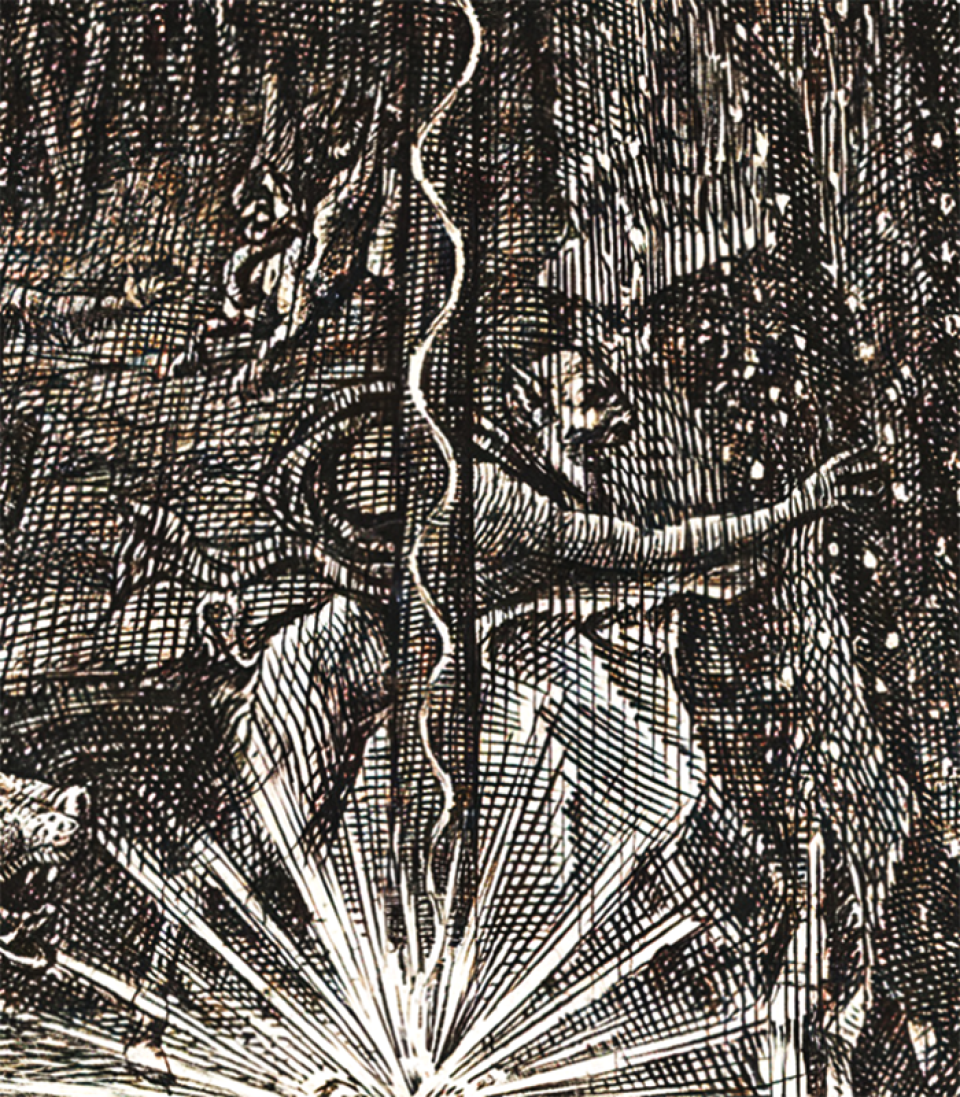
On the islet upon which the symbolic old man is located, some creatures can be seen, with an effort of concentration. For example, at the foot of the islet we see an animal that is none other than the mythological basilisk ─see detail 8─, a creature that many alchemist treatises point out as highly pernicious, because it speaks of the bad treatment we can give to our Mercury, the volatile element. This basilisk, as it was always shown, has the claws of a bird of prey, the tail of a worm and wings different from those of a rooster.
We can also see a toad at the foot of the rock ─see detail 7─ with a Latin inscription. Let us remember that the toad or the frog are the symbol, among many ancestral cultures, of the transmutatory art or alchemical art. It is enough to remember the existence, in the ruins of the Templo Mayor [Main Temple] of the ancient Aztecs, nothing less than a pool that the Mexica dedicated to the frogs that are sculpted around it. This toad in our engraving is accompanied by a Latin phrase that reads as follows: Sedet aeternum qve sedebit ifoelix. The translation of this phrase is as follows: ‘He is sitting, nevermore to rise.' The recited phrase points to Theseus, who was, according to mythology, trapped in Hades ─hell─ due to his sexual transgressions. However, this is the destiny of the fornicating humanity that will involute and remain for terrible ages there in the avernus or hell, paralyzed for millennia.
It is worth noting that, on the stone with the aforementioned phrase, a scorpion can be seen, although in a tiny form, ─see detail 7─. The scorpio is the symbol of the zodiacal constellation of Scorpio. Such a sign governs sexuality in the human anatomy, and this is in accordance with the phrase that we have already shown and revealed.
On the other hand, right there, in that dark framework, three owls can be seen. The owl, in esoteric symbology, warns about the imperative need to live in a state of permanent alert in order to capture the EGO in action, to detect it in order to study it, understand it and eliminate it with the timely assistance of the divine Eternal Feminine ─Stella Maris, Devi-Kundalini─, as indicated by Gnosis.
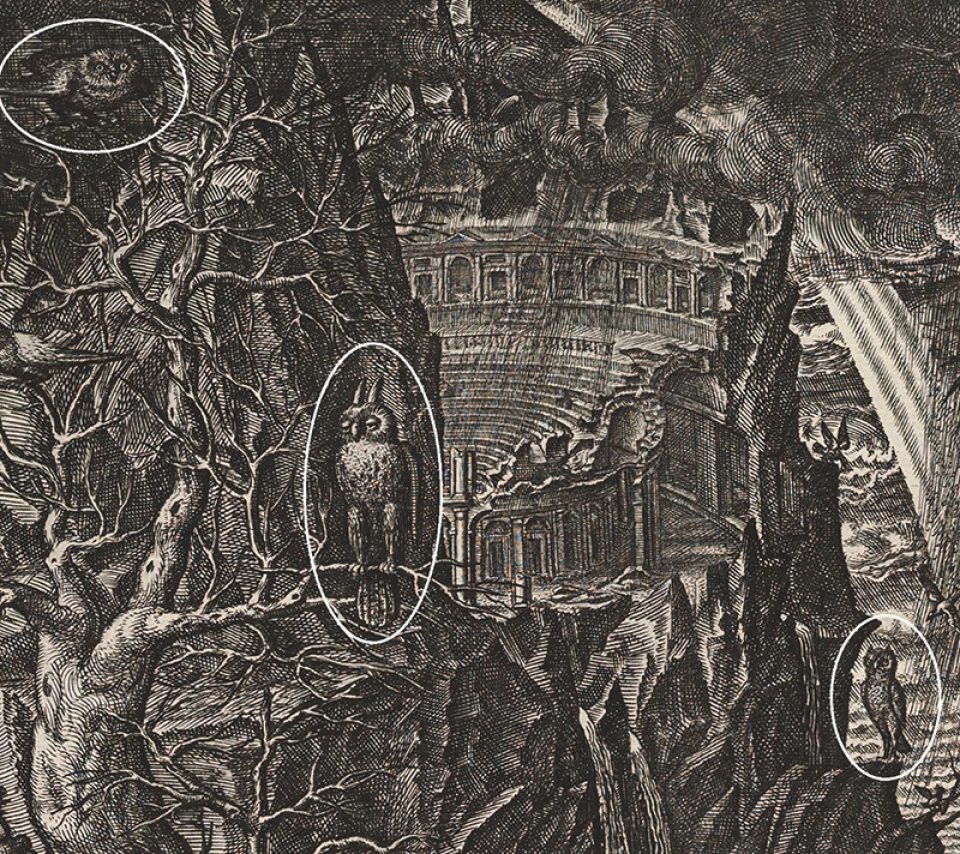
Let us also point out that among those strange creatures that we are mentioning, close to the rock, on one of its sides, is a bat ─see detail 5─. The bat alludes to the states of darkness that flood the psyche of the rational mammal.
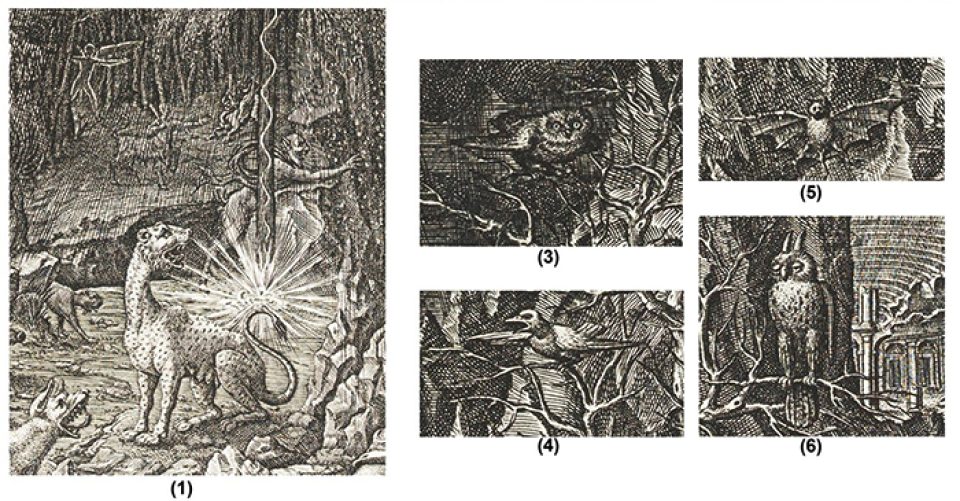
It is good to see that, in the dark framework in which the devotee is found, in the upper part of it, there are ruins of what was once a coliseum ─see detail 9─. That coliseum points to human vainglory that sooner or later turns into ruins, it was part of a time and ended in another time.
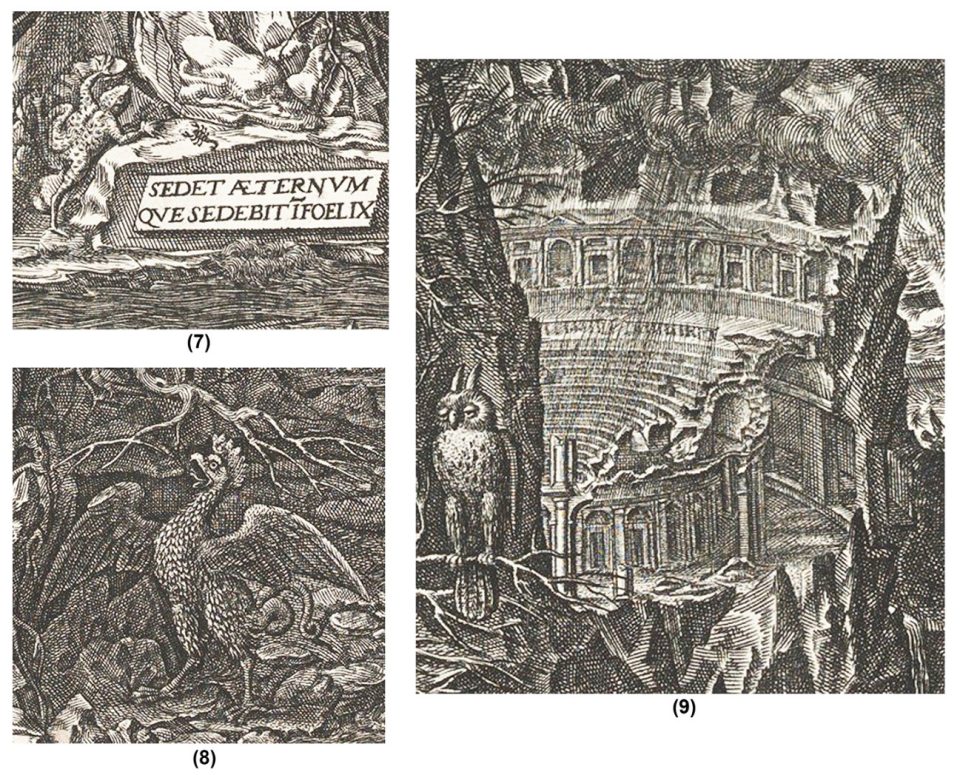
Likewise, it is worth commenting to our esteemed readers that in that same dark and pernicious framework where the owls are found we can also see a raven ─see detail 4─, and also in the lower left part of the engraving. The raven, in esoteric allegory, represents the death of our psychological aggregates. The raven is associated with Saturn, and Saturn, in the alchemical theme, alludes, indicates or points to death, to the putrefaction of the unhealthy entities that constitute the “I”, the EGO, the Myself, the Oneself, etc., etc., etc.
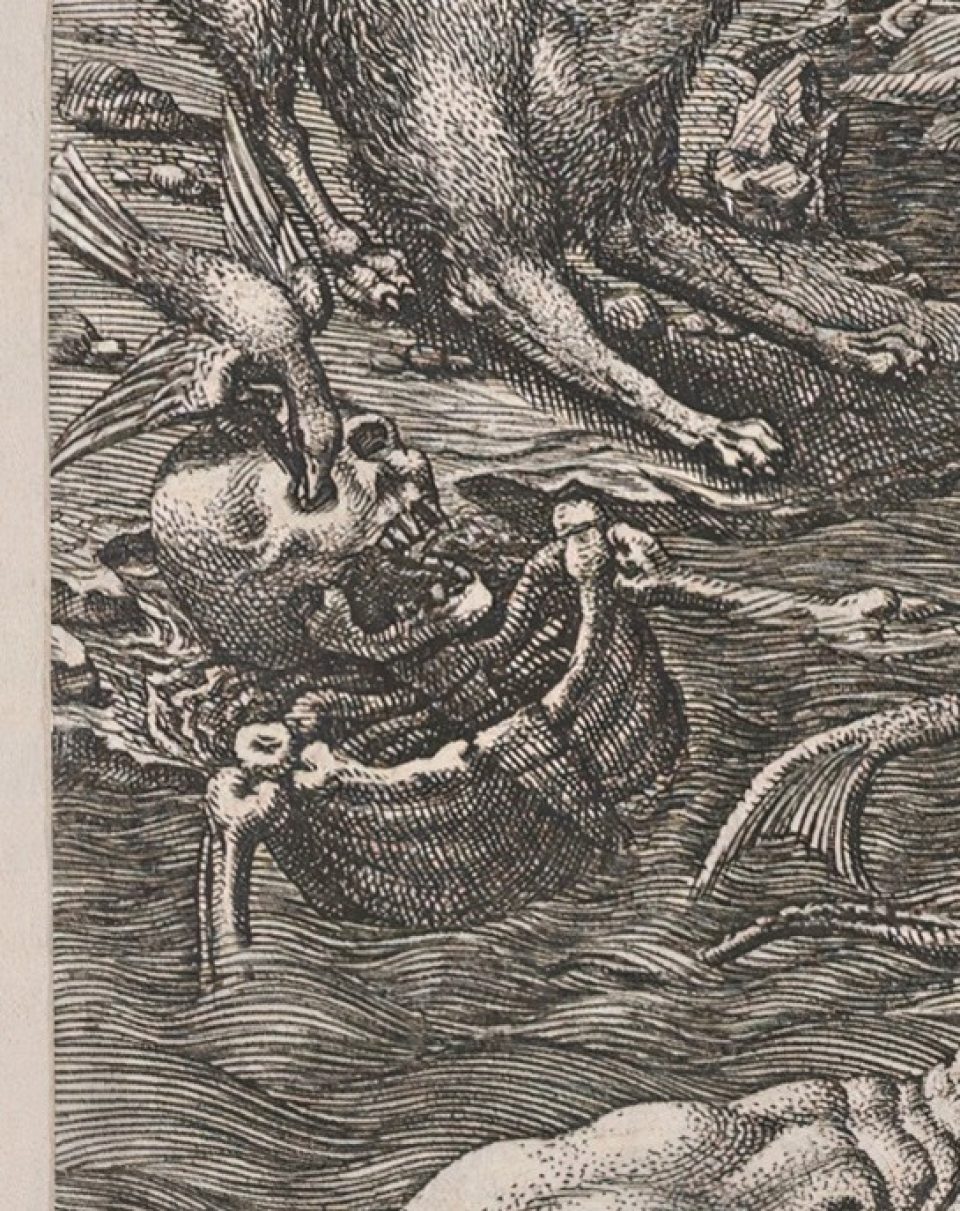
There is a rainbow that separates the dark side of the engraving from that other, more luminous side. That rainbow points to the hope that earthly man has to one day become the true Solar Man regenerated and awakened to higher realities.
On one side of the mentioned rainbow we can see a sun that begins to rise on the horizon. That sun is the new day, the immortal dawn which we must greet when our animic nature has conquered Mastery in the kingdom of the Father.
On this other, more luminous side of this artistic work, it is convenient to focus first of all on the beautiful lady who carries a lance in her left hand, while with her right hand she is touching a splendid palm tree. That woman is none other than the Divine Lady of our inner fires, called in various cultures by very varied names, namely: Minerva, Athena, Sophia, Aka, Astarte, Marah, Mary, etc., etc., etc. It is She who extirpates the demons that have imprisoned our Consciousness from our spiritual anatomy, with that lance of phallic character. Obviously, She is linked to our REAL BEING because She in Herself is one of the autonomous and self-conscious parts of Him. She is the very astral signature of the Secret Fire, and for this reason She is also called Devi-Kundalini in the East, the igneous serpent of our magic powers. We the Gnostics call Her RAM-IO, a word that becomes, moreover, the mantra with which we evoke Her.
At the top of that palm tree, symbol of our own BEING, three cherubs can be seen ─detail 10─. These three cherubim are the representation of the three primordial forces of creation: Holy Affirming, Holy Denying and Holy Conciliating. These are the three blessed forces that are at the origin of all creation since the dawn of time. One such cherub holds a tempered bow in his hands, pointing his arrow at the sage or philosopher of the Secret Path to incite him to make the journey to eternity at the risk of everything.
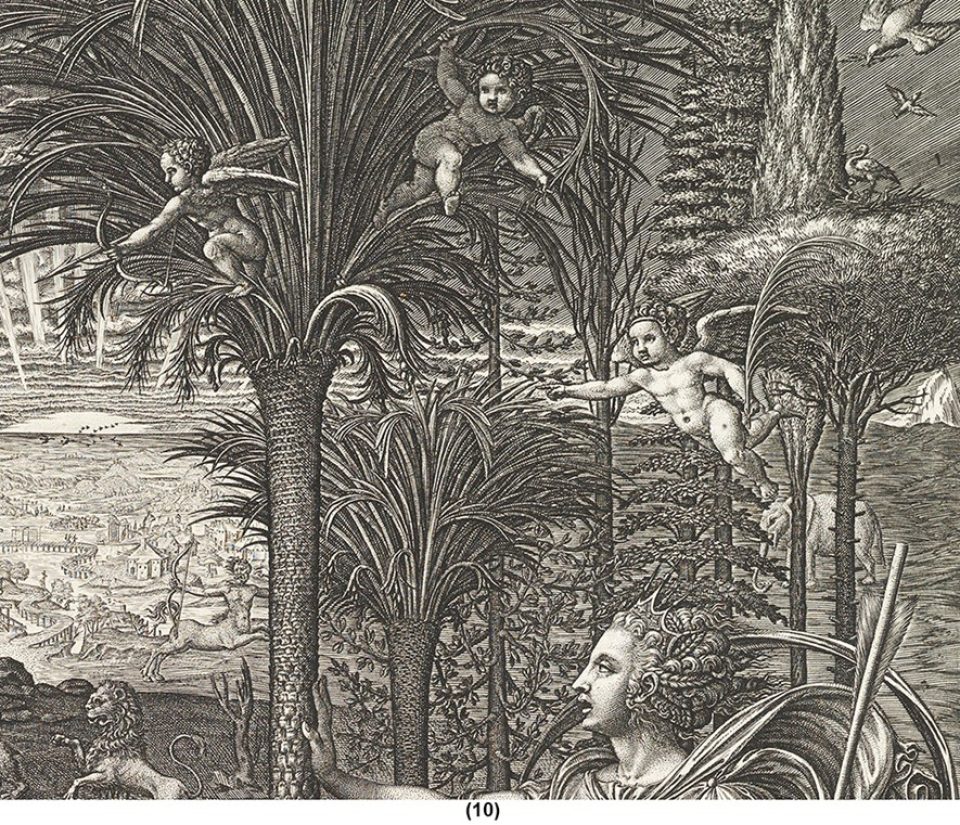
Beyond the scene that speaks to us of the divine Eternal Feminine and the three cherubim, we can easily observe a citadel, and within that setting appears before our eyes a centaur carrying in one of his hands ─the right one─ a bow. This is the image of the zodiac sign that alludes to the sign of Sagittarius. What is interesting about this image is the fact that it represents man, who must launch the arrow of his longings toward the heavens of Consciousness, toward divinity, requesting help to return to the original starting point.
Also as part of that luminous side of our engraving, up above we see a dove that embodies the Holy Spirit, who is always ready to rescue us from the world of illusions to introduce us into the universe of great realities. Our dove carries in its beak a blade of straw to show us that the force of the Third Logos is always at work seeking to fix our nest for our protection against darkness.
In the same way, near the cherubim we see, on the top of a tree, a stork. The stork, in itself, has always represented divine motherhood. With this our return is promised, to the primordial childhood or innocence, which we have lost because of our angelic fall according to the Holy Scriptures. Such a stork, in addition to having its chicks, carries an egg on one of its legs. This is to indicate that the force of the Third Logos is always creating new lives and new material and spiritual forms.
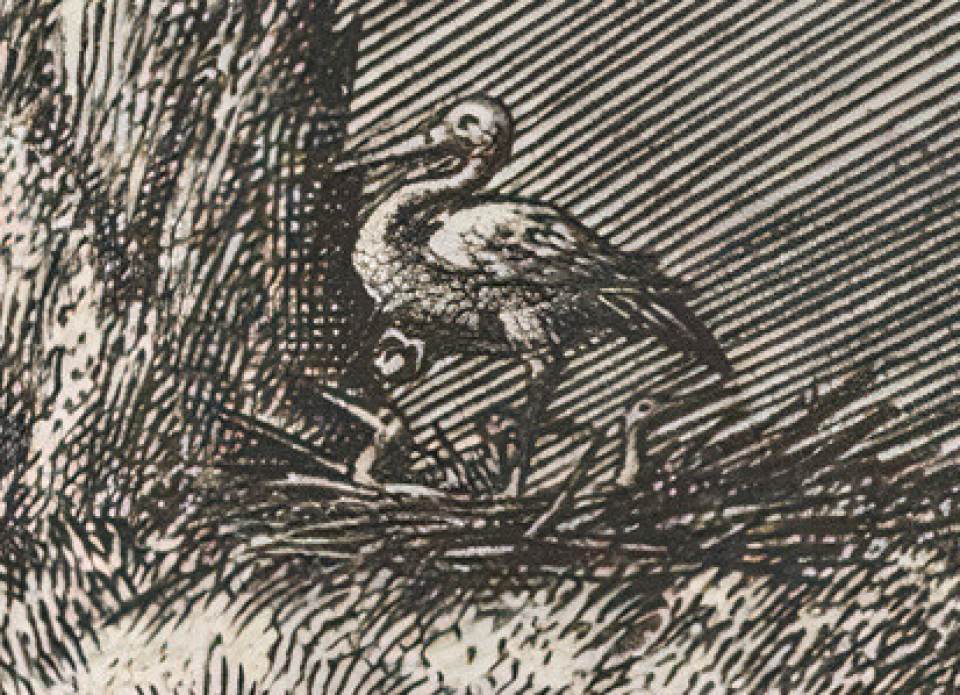
As if that were not enough, at the height of the head of the mythological woman we have already talked about we can see, among some trees, an elephant. This extraordinary mammal, in pure Gnosticism and transcendental symbology, points to the primordial Logos, to our Kether, to the power of the Ancient of Days, who always watches over our journey through the carousel of our existences.
On the other hand, we must tell our esteemed readers that, in the dark framework in which the devout old man finds himself, the following images are seen behind him ─detail 2─, namely:
- An angel.
- A centaur carrying a club in his hands.
- A creature that looks like a tiger but with breasts on its back and udders like a cow.
What is this? Answer: The angel represents the divine forces that move through the darkness to rescue lost souls. Likewise, the centaur with the club allegorizes the common man and his violent passions. The creature with udders and breasts on its back are deformations that our psychological aggregates have as they involute throughout the millennia.
To conclude, I attach some sentences that I consider appropriate to reflect upon:
“To the wise no truth is bitter.”
Maurice Maeterlinck
“Every truth that appears on Earth is sealed with the blood of a martyr or a prophet.”
Lamartine
“After all, after all, the truth suffers but does not perish. Truths are hard to suffer.”
Saint Teresa
“All men seek the truth, but only God knows who has found it.”
Chesterfield
“The most obvious sign that the truth has been found is inner peace.”
Amado Nervo
“Truth is a nettle: he who just slightly touches it, is hardly pricked; to those who take it with force and resolution it does nothing.”
M. G. Saphir
SURSUM CORDA
─'Lift up your hearts'─
KWEN KHAN KHU


